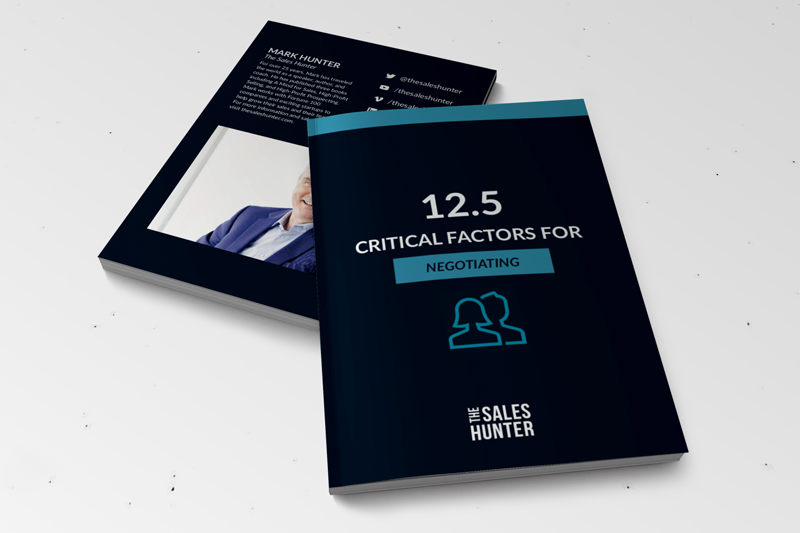Guest post Monday and we have Gary Hart, who has an extensive sales career and is president of Sales Du Jour. Such transparency in this post about what Gary learned didn’t work — and how he saw greater success when he changed his approach.
I’m a recovered “objection killer.”
99.9% of sales attempts meet objections. In the early days of my sales career, I trained to exterminate objections on sight. Unfortunately, the “you have a problem, we have the solution” method undermined my customer’s real concerns and killed many sales for me.
On the emotional intelligence scale, I was a Neanderthal. The buyer knew I was armed with slick answers. They heard every version of don’t worry and here’s a case study — and had read countless lists of testimonials.
My singular purpose of getting the sale was not disguised.
It belittled and invalidated my customer’s real concerns without properly addressing them.
Objections are a Secret “Yes”
When I heard an objection, I thought I was hearing “no” and went into my “defend-the-sale” mode. What I learned was the buyer often meant, “I’d like to make this purchase, but I have some concerns, and if you can help me, we can do business together.”
Objections are an Expression of Concern
Objections are more than roadblocks to doing business with us. The decision-making process has emotional depth, especially in these times of economic uncertainty. If Carol Bartz can be fired by telephone and HP can send Leo Apotheker packing as they bring in their 4th CEO in six years, who has job security?
Every offering is dissected under an electron microscope.
When I charged in with solutions and fixes, my customers shut down and tuned me out. When I learned to acknowledge and understand the buyer’s concerns, my results improved dramatically. In addition to developing trust by making their needs important, I found that the customer brought me into their corner to help them buy!
The selection and installation logistics of the equipment I sold was very complex. One snag could shut down a product line or entire facility for hours, days, or longer. I had the experience, knowledge and organization for smooth implementation, but that is not what the customer wanted to hear.
The 6 Journalist’s Questions are Your Best Friend
The answers to who, what, when, where, how, and why give us a six dimensional perspective. Here are some ideas:
Who is behind the objection?
There were a lot of fingerprints on my sales. Everyone from the production floor to the VP of Manufacturing and higher had a say. I’ve had sales held up because of a solitary production worker.
Who is making the objection? Is it a group or individual?
Find out and go directly to the source — with permission. Enlist the messenger as a sponsor and a referral; they will probably appreciate being removed from the middle.
What is the real objection?
We have all heard objections that are not always the real issue. This is not to say the buyer is lying. When dealing with sales professionals, people are protective. Objections are a natural defense mechanism. Whenever I was unsure, I asked a simple question, “In addition to this, is there another challenge you’re facing?”
When did the objection come up?
Little is more frustrating than facing an obstacle late in the sales cycle. We know most of the objections related to our offering. Presenting them early can prevent long trips down dead-end roads. Questions that uncover potential deal killers will help you control the when. Better to learn early in a sale than when you have a lot of skin in the game.
Where is this causing a problem?
Organizations are complex ecosystems. One small kink in a water hose can stop the entire flow. When the problem was in programming, I went to the programmers; when it was on the shop floor, I spoke with plant manager and operators. Find the kink and work a solution there, not in the wrong office with sales rhetoric.
How big of an issue is this?
A common knee-jerk reaction for salespeople to objections is “This is a deal killer.” This is typically followed by discounting and concessions. If we don’t ask this simple question, we’re simply guessing and weakening our position.
Why is this an obstacle?
The same objections are likely to be raised by different members of the buying team and different organizations. What I learned was the reasons were rarely the same. Knowing why points to the solution.
Successful management of objections is the result of investigation and discover of the entire story in a timely fashion.
 Gary Hart’s career as an advertising, marketing, and sales executive began in 1971. As VP of Sales & Marketing, Gary led an 800% sales increase for a high-tech equipment company to $20 million per year over a 5-year span. Hart’s accounts included Toyota, Avis and Cartier, as well as small and medium businesses.
Gary Hart’s career as an advertising, marketing, and sales executive began in 1971. As VP of Sales & Marketing, Gary led an 800% sales increase for a high-tech equipment company to $20 million per year over a 5-year span. Hart’s accounts included Toyota, Avis and Cartier, as well as small and medium businesses.
Gary has a passion for building high performance sales teams by simplifying and streamlining the sales process. Hart is currently the president of Sales Du Jour and also involved in non-profit organizations with children oriented missions.













One Response